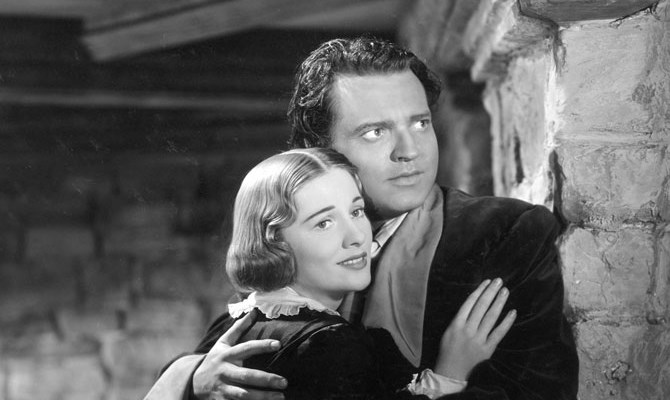
‘Look, weren’t the Victorians cruel?’ My mother’s running commentary on the early years of Jane Eyre is indelibly tied to my memory of first watching the 1943 film on TV as a child. We still flinch with earnest anger like young Jane (Peggy Ann Garner) when her boarding school friend (an uncredited Elizabeth Taylor) has her natural curls hacked off for being ‘vain’. This is a world ruled by callous, hatchet-faced patriarchs, and this film still seems definitive in its faithfulness to Charlotte Brontë’s heroine, driven by honesty and a sense of natural justice.
The concept for the picture was put together by David O. Selznick, best known as producer of Gone With the Wind. However, British director Robert Stevenson created a perfect storm of Gothic feminist grandeur with his only film for 20th Century Fox. He went on to make such female-focused Disney masterpieces as Mary Poppins and Bedknobs and Broomsticks.
And what talent illuminates the screen: Bernard Hermann wrote the score. The cinematography and lighting cast the perfect shadows; mysterious figures lurk in the gloom and the forbidding crenellated stone walls of Thornfield Hall. The script, co-written by Stevenson with Aldous Huxley and John Houseman, brings the rich textual world of Jane Eyre to life, maintaining its diary-like first person narrative. Orson Welles, in his physical prime, and so often at his best when not officially in charge, added the fog which gives the entirely Hollywood-shot locations a never-bettered Gothic air—something I do find missing from modern productions. Joan Fontaine may not have been any more an authentically ‘plain’ Jane than later actresses but carries it more discreetly. This is a Jane of dignity and buried passions. Agnes Moorehead is a death’s head profile—a grim yet ultimately pitiful Aunt Read.

Visiting the Brontë Parsonage Museum earlier this year for a Radio 4 Front Row special, I noticed a film still from a silent version of Wuthering Heights (sadly lost) in which Heathcliff crouches like Nosferatu by the bedside of Cathy. Lauren Livesey of the Brontë Society told me the idea of representing such Brontë heroes as ‘sexy’ rather than scary was the influence of Rebecca, released 3 years earlier, also starring Joan Fontaine and featuring Laurence Olivier as Maxim de Winter. It has cast a long shadow; the representation of such men is just one of many facets that make the Brontë phenomenon a fascinating subject for debate.
Lauren Livesey will be part of our panel discussion, alongside novelist Mick Jackson, who brings a welcome male perspective and the creative insight of having written about the Brontës’ global tourist appeal. 19th century literature scholar Dr Amber Regis can help unpick the imagery of books and films and their influence on modern ideas of psychology, romance and feminism. Together we might reflect on the red room, where Jane is locked for punishment; the madwoman in the attic that spawned a thousand feminist theories; the world of slavery and Empire linked to the characters’ backstories in cotton mills, sugar plantations and plans to be missionaries in India.
We’ll reflect on the different screen versions of these much-loved stories—I should declare my favourite Brontë is actually Anne.
Here at the National Media Museum—the home of storytelling through visual images—we will reflect on the future prospects for these stories. Jane Eyre might have gone off to India with St John after she runs away from Thornfield. I love the idea of all these alternative storylines: the multiverse of choices and outcomes that Jane might have, that perhaps a more game-focused narrative could explore. One day might someone create Jane Eyre: the Choose Your Own Adventure immersive videogame?
Imagine, too, the atmosphere in which British audiences first saw this film—released on Christmas Eve in 1943. This is not a film of romantic nostalgia for a happier time. It’s about endurance and determination despite the cost of injury and physical destruction. Of making peace, after long years, with cruel and powerful people who have wronged you. But it is also about holding out for victory. I have never seen an onscreen kiss more erotic than the one between Joan Fontaine and Orson Welles in Jane Eyre. It makes me blush every time I see it. Be there to share it with us.
On Saturday 9 July 2016, Samira chaired a special panel discussion and Q&A to accompany our screening of Jane Eyre, starring Joan Fontaine and Orson Welles.